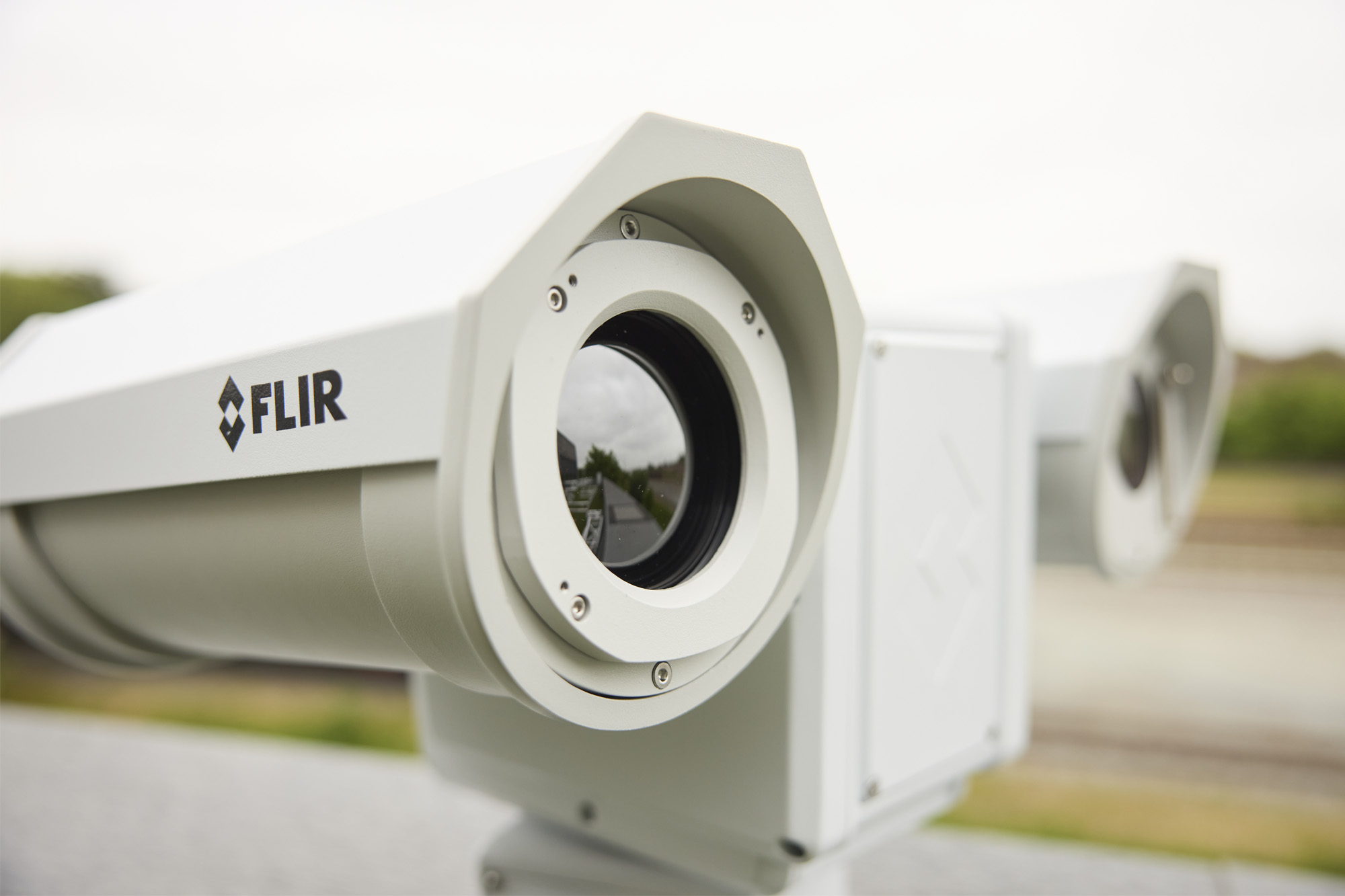In times of growing security requirements and increasing complexity of industrial infrastructures, classic video surveillance is no longer sufficient. Critical infrastructures such as energy plants, data centres, logistics hubs and port terminals are under growing pressure to secure their perimeter and site surveillance not only visually, but also intelligently and robustly.
This is precisely where the new FLIR PT‑Series AI SR comes in – a multispectral PTZ camera system with integrated edge AI and outstanding sensor technology. In the following technical article, we take a detailed look at the technology, application and cost-effectiveness – and show why this camera heralds a new era in security architecture.
Multispectral image fusion: Why ‘seeing’ alone is no longer enough
The PT‑Series AI SR combines two different but ideally complementary sensor technologies: a visible 4K sensor and a thermal sensor with a resolution of 640 × 512 pixels. The thermographic detector responds to minimal temperature differences of less than 25 mK (NETD), reliably detecting movement and heat sources even in complete darkness or poor weather conditions. The camera merges this data with the visible image, enabling not only day and night surveillance, but also significantly higher detection reliability in complex environments.
An outstanding feature is the 4x continuous optical zoom, which allows razor-sharp detailed images despite PTZ functionality. This zoom is not digitally interpolated, but mechanically implemented – a significant advantage over purely digital zoom solutions, which quickly reach their limits at high magnifications.
The camera operates on a pan-tilt platform, enabling it to react dynamically to detected objects and follow them automatically. This feature proves invaluable in dynamic scenarios, such as when intruders, approaching vehicles or patrolling security forces are detected.
Edge AI meets intelligent camera networking
What makes the PT‑Series AI SR particularly future-proof is not just its optics, but also its on-board intelligence. Instead of sending raw data to central servers, the system analyses image content directly in the camera (‘on the edge’).
The integrated AI classifies objects independently – reliably distinguishing between people, vehicles and animals – and thus enables targeted alarms or control based on object type.
The proprietary FLIR Nexus® communication protocol further expands the camera’s capabilities by enabling intelligent collaboration between multiple cameras in a single system. For example, if one camera detects an object, it can transmit its coordinates to neighbouring units, which automatically pan into position and seamlessly take over the object. This feature, also known as ‘target handoff’, reduces surveillance gaps and ensures that critical events are continuously tracked without human intervention.
As a result, security networks can be made denser and more efficient without exponentially increasing the number of cameras. This offers significant savings potential and improved quality, especially for operators of large facilities.
Practical applications: Versatile, scalable and resilient
The PT‑Series AI SR is ideal for large-scale, security-critical applications. In oil and gas facilities, for example, where the safety of employees and equipment is a top priority, it enables early detection of approaching persons – even using thermography in the most adverse visibility conditions. Data centres, where high security requirements go hand in hand with structural and lighting restrictions, also benefit from the camera’s powerful night vision capabilities.
The camera also proves its worth in ports and logistics centres, where container areas, parking spaces and access roads can be monitored dynamically. The ability to track objects – whether people, vehicles or forklifts – enables real-time tracking throughout the entire factory premises.
In smart city environments or at airports, the range of applications is expanded to include behaviour-based security analytics: The camera can not only register movements, but also recognise patterns – such as groups of people gathering, unusual movement patterns or vehicles in prohibited zones. These functions form the basis for modern risk analysis in public spaces.
Planning and integration aspects: Flexible, hybrid and future-proof
For security planners and system integrators, the first question that arises during implementation is how to position the cameras optimally. A hybrid approach is recommended: stationary 4K cameras secure defined zones, while rotating PT Series cameras monitor flexible, large areas. Thanks to their thermal expertise, they cover distances of several hundred metres – a long range with low installation effort.
Integration into the network is via LAN or PoE+, and the system can also be connected via microwave radio. Since Edge AI handles a large part of the processing, central server resources are conserved, which both reduces costs and improves scalability. The system architecture thus allows for both centralised and decentralised operating concepts.
The user interface is web-based and clearly designed.
Objects are visually marked with bounding boxes, can be prioritised, classified and integrated into defined responses. Thanks to standardised protocols such as ONVIF, the cameras can be easily integrated into existing VMS, PSIM or SCADA systems.
Cost-effectiveness: intelligence as investment protection
An outstanding advantage of the PT‑Series AI SR is its cost-effectiveness. The holistic approach – consisting of integrated AI, multispectral sensor technology and automated camera control – reduces the total cost of ownership over the system’s life cycle. Fewer cameras are required because the range and analysis quality per device are significantly higher. Network infrastructure and central hardware can be designed more leanly, and maintenance costs are reduced thanks to modular updates and clear status monitoring.
Investment risks are also minimised: existing networks can be expanded modularly – new PT cameras can be added as demand grows without changing existing structures. The combination of scalability, flexibility and efficiency is particularly appealing to operators who value sustainability and future-proofing.
Limitations and challenges: transparency creates trust
Despite all its strengths, the PT-Series AI SR remains a system with defined technological limitations. Edge-based AI is resource-efficient, but in very complex scenarios with a high variety of objects – such as zoos or busy transition zones – the processing load can reach its limits.
In such cases, it is advisable to supplement the system with external analytics modules or server-based additional processing.
Adapting the AI models to specific environments also requires some effort. FLIR offers configurable classification models and training options, but this requires expertise on the part of the integrator. Environment-related false detections can be minimised through individual model tuning.
Last but not least, legal requirements must be observed: the use of cameras with person identification is regulated by data protection laws in many countries. The camera supports functions such as masking, image area blanking and storage restrictions – nevertheless, data protection-compliant planning must be taken into account at an early stage.
Sensory intelligence as a building block for networked security architectures
The PT‑Series AI SR is more than just a camera – it is a building block for modern security ecosystems. In combination with access controls, thermal gates, motion analysis and cloud-based data platforms, a networked, automated surveillance architecture can be realised.
Stand-alone solutions are increasingly giving way to sensor networks – with low failure rates, high interoperability and minimal operating costs.
For system integrators, this means a new role: from installer to service provider for permanent status monitoring, alarm configuration, model maintenance and cybersecurity. FLIR offers training and certification for this – an attractive added value for companies that rely on long-term service contracts and deep customer loyalty.
Technological excellence meets economic viability
The FLIR PT‑Series AI SR is a prime example of modern, integrative perimeter security. Its multispectral sensor technology, combined with edge AI and automated PTZ control, enables unprecedented precision, response speed and scalability – while reducing resource requirements.
For operators of large, security-critical facilities, it is an essential tool for keeping pace with increasing demands – without having to invest in cost-intensive infrastructure or oversized personnel structures. For planners and system integrators, a new field of technology is opening up that offers solutions that are flexible, robust, intelligent and future-proof.
Article also available as a PDF download: https://euro-security.de/wp-content/uploads/2025/07/ES_DACH-6-2025S27-29.pdf


